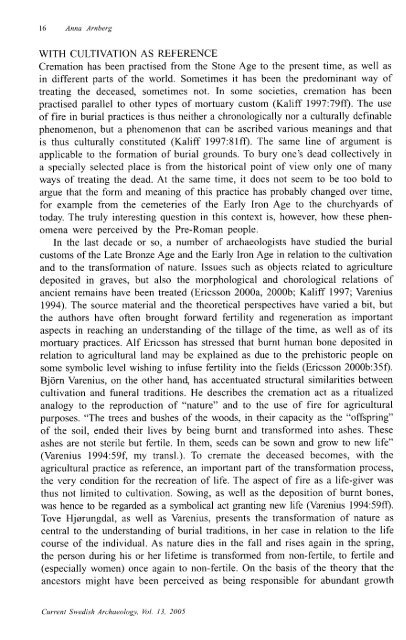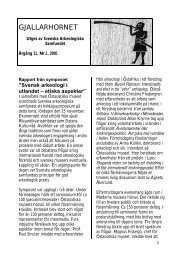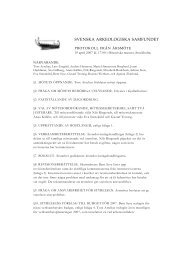Fields, Funerals and Furnaces Anna Arnberg - Svenska ...
Fields, Funerals and Furnaces Anna Arnberg - Svenska ...
Fields, Funerals and Furnaces Anna Arnberg - Svenska ...
Create successful ePaper yourself
Turn your PDF publications into a flip-book with our unique Google optimized e-Paper software.
16 <strong>Anna</strong> Arnbetg<br />
WITH CULTIVATION AS REFERENCE<br />
Cremation has been practised from the Stone Age to the present time, as well as<br />
in different parts of the world. Sometimes it has been the predominant way of<br />
treating the deceased, sometimes not. In some societies, cremation has been<br />
practised parallel to other types of mortuary custom (Kaliff 1997:79'.The use<br />
of fire in burial practices is thus neither a chronologically nor a culturally definable<br />
phenomenon, but a phenomenon that can be ascribed various meanings <strong>and</strong> that<br />
is thus culturally constituted (Kaliff 1997:81ff). The same line of argument is<br />
applicable to the formation of burial grounds. To bury one's dead collectively in<br />
a specially selected place is from the historical point of view only one of many<br />
ways of treating the dead. At the same time, it does not seem to be too bold to<br />
argue that the form <strong>and</strong> meaning of this practice has probably changed over time,<br />
for example from the cemeteries of the Early Iron Age to the churchyards of<br />
today. The truly interesting question in this context is, however, how these phenomena<br />
were perceived by the Pre-Roman people.<br />
In the last decade or so, a number of archaeologists have studied the burial<br />
customs of the Late Bronze Age <strong>and</strong> the Early Iron Age in relation to the cultivation<br />
<strong>and</strong> to the transformation of nature. Issues such as objects related to agriculture<br />
deposited in graves, but also the morphological <strong>and</strong> chorological relations of<br />
ancient remains have been treated (Ericsson 2000a, 2000b; Kaliff 1997; Varenius<br />
1994). The source material <strong>and</strong> the theoretical perspectives have varied a bit, but<br />
the authors have often brought forward fertility <strong>and</strong> regeneration as important<br />
aspects in reaching an underst<strong>and</strong>ing of the tillage of the time, as well as of its<br />
mortuary practices. Alf Ericsson has stressed that burnt human bone deposited in<br />
relation to agricultural l<strong>and</strong> may be explained as due to the prehistoric people on<br />
some symbolic level wishing to infuse fertility into the fields (Ericsson 2000b:35f).<br />
Björn Varenius, on the other h<strong>and</strong>, has accentuated structural similarities between<br />
cultivation <strong>and</strong> funeral traditions. He describes the cremation act as a ritualized<br />
analogy to the reproduction of "nature" <strong>and</strong> to the use of fire for agricultural<br />
purposes. "The trees <strong>and</strong> bushes of the woods, in their capacity as the "offspring"<br />
of the soil, ended their lives by being burnt <strong>and</strong> transformed into ashes. These<br />
ashes are not sterile but fertile. In them, seeds can be sown <strong>and</strong> grow to new life"<br />
(Varenius 1994:59f, my transl. ). To cremate the deceased becomes, with the<br />
agricultural practice as reference, an important part of the transformation process,<br />
the very condition for the recreation of life. The aspect of fire as a life-giver was<br />
thus not limited to cultivation. Sowing, as well as the deposition of burnt bones,<br />
was hence to be regarded as a symbolical act granting new life (Varenius 1994:59ff).<br />
Tove Hjerungdal, as well as Varenius, presents the transformation of nature as<br />
central to the underst<strong>and</strong>ing of burial traditions, in her case in relation to the life<br />
course of the individual. As nature dies in the fall <strong>and</strong> rises again in the spring,<br />
the person during his or her lifetime is transformed from non-fertile, to fertile <strong>and</strong><br />
(especially women) once again to non-fertile. On the basis of the theory that the<br />
ancestors might have been perceived as being responsible for abundant growth<br />
Current Swedieh Arehaeology, Voh l3, 2005






